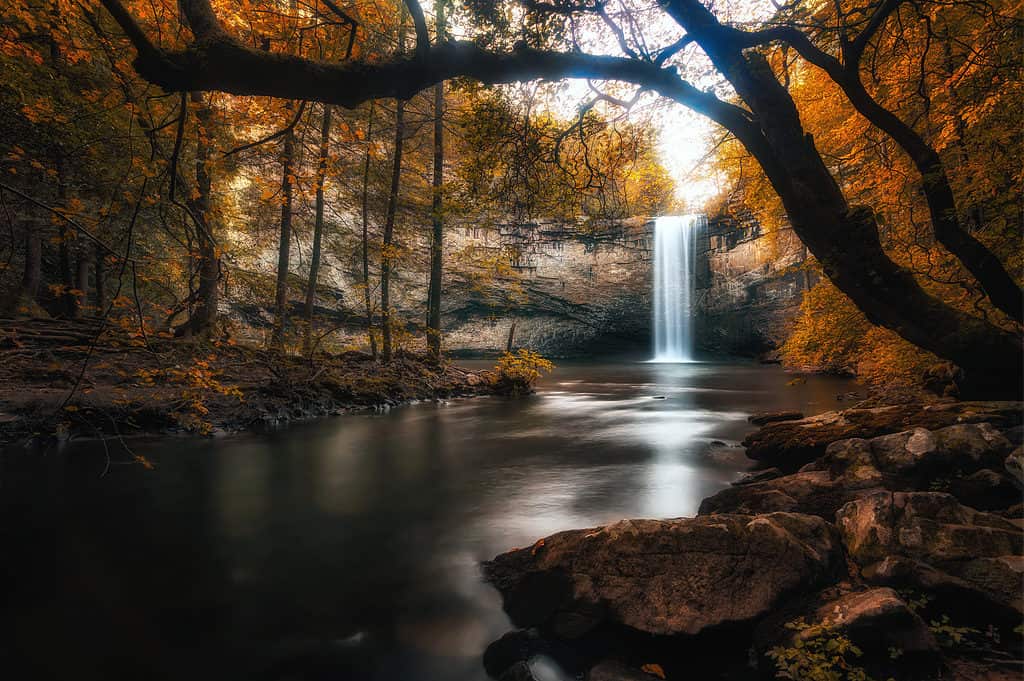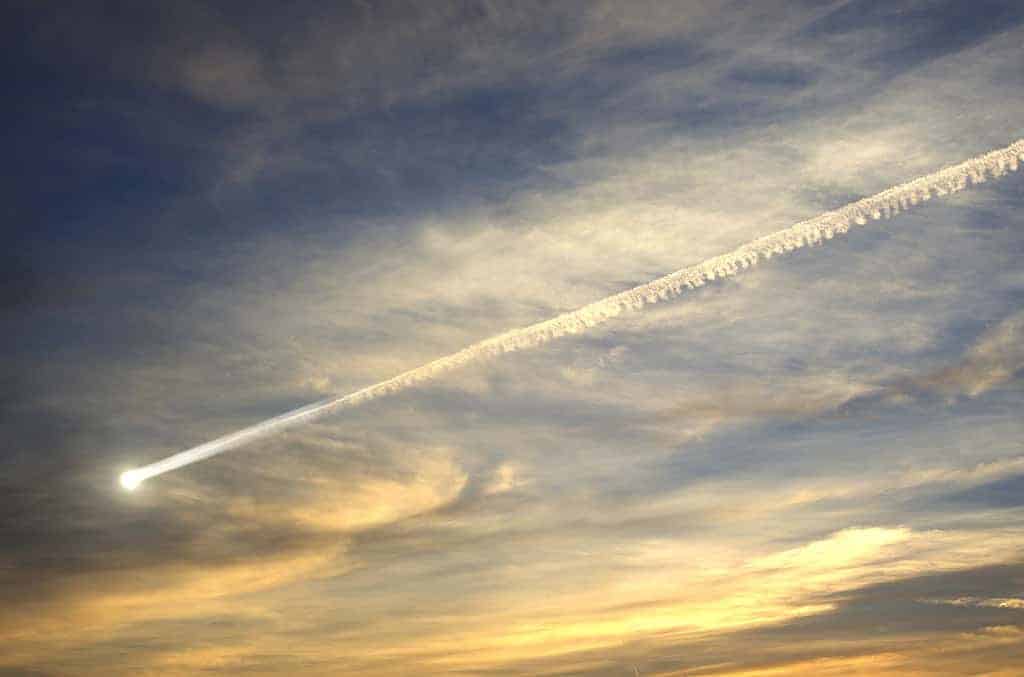In the long history of our world, the planet has been peppered with more meteors than we can imagine. Just look at the Moon. Without wind, water, or tectonic activity to erode the craters, the moon gives a good indication of the meteor impacts throughout time. Similar meteors have affected Earth and at least three meteors have impacted Tennessee. We’ll tell you the locations of these impact sites, along with the biggest impact crater in Tennessee.

Tennessee is a calm, peaceful place today, but back in prehistoric times, it was downright apocalyptic.
©Rob Du Bois/Shutterstock.com
Tennessee’s Three Craters
Tennessee has three major meteorite impacts that we know of. These impacts are over 200 million years old. However, as much as 1,000 feet of soil may have eroded away since then.
- The Howell Structure – a one-mile diameter crater north of Fayetteville in Middle Tennessee
- The Flynn Creek Structure – a crater three miles in diameter northwest of Cookeville in east Tennessee
- The Wells Creek Basin – a 10-mile diameter crater in Cumberland City in northwestern Tennessee
Due to heavy erosion, geologists are unable to know the exact size of the meteors. However, they were likely quite a bit bigger than the remaining impact sites. We will discuss the details of a meteor that could create a 10-mile hole in the ground, such as the one at Wells Creek.

Clarksville, Tennessee is located 24 miles northeast of the largest impact crater in Tennessee.
©Real Window Creative/Shutterstock.com
How Big Was the Wells Creek Explosion?
Estimating the size of the explosion that created the Wells Creek crater is difficult because there are so many variables. What was the size and density of the object? Was it made of solid rock and metal or was it a loosely compacted comet with a high component of gas and dust? What was the terrain like where it hit 200 million years ago? How fast was the object moving and at what angle? Did it explode in the atmosphere or did it make physical contact with water or solid land? And just how big was the crater before erosion? With no exact answers to these questions, it is really hard to say with any certainty how big the explosion was.

Meteors enter the Earth’s atmosphere, but most are small enough to burn up in the atmosphere.
©Krasowit/Shutterstock.com
Best Guess: It Was Big!
Generally speaking, though, to make a crater 10 miles wide, it would take an object about 4,200 feet wide – the length of the Golden Gate Bridge! The impact would release the equivalent energy of an earthquake measuring over 12.4 on the Richter Scale. Note that the largest earthquake ever measured was a 9.5 measured in Chile in 1960. More recently, the 2004 Indian Ocean earthquake that set off a deadly tsunami was a 9.1 on the Richter Scale. A meteor of 12.4 magnitude would shove aside the atmosphere in just a few seconds as it tore into our planet’s atmosphere at many times the speed of sound. The impact would pulverize and superheat the material of the Earth’s crust and suck it up into the atmospheric hole that it created. Gravity would pull down the burning material, creating a hellish rainstorm. This would set off forest fires many miles from the impact site. Prevailing winds would carry an enormous cloud of smoke and ash across the Eastern United States and, if the explosion was big enough, could darken skies around the Northern Hemisphere for many weeks or months.

The Wells Creek meteor in Tennessee may have been as wide as San Francisco’s Golden Gate Bridge!
©canadastock/Shutterstock.com
Animals of Tennessee, Then and Now
Triassic-Jurassic Tennessee
Almost 200 million years ago was the end of the Triassic Period, just before the start of the Jurassic Period. During this time Tennessee was mainly above sea level and was heavily eroded. As a result, there is a gap in the rock and fossil record from the Permian, Triassic, and Jurassic Periods. The Triassic-Jurassic extinction event happened at this time, causing a large percentage of life on Earth to disappear. It’s unclear what caused it, but among the leading theories are climate change, volcanic eruptions, and meteor impacts. Tennessee’s impact craters may certainly have been part of this global catastrophe. Some of the dinosaurs that lived in North America at that time were the camposaurus and dilophosaurus, as well as carnivorous theropods and herbivorous long-necked sauropods.

At the time of the Wells Creek meteor impact, Tennessee was a living version of
Jurassic Park.
©Cheng Wei/Shutterstock.com
Tennessee Animals Today
Things have changed a little in Tennessee over the years. Today, the closest thing you’ll encounter to a dinosaur is an alligator, a species that has been spreading into West Tennessee from states further south. The state has a wide range of snakes, including some venomous ones like the cottonmouth, timber rattlesnake, and copperhead. Some of the larger mammals in the state are the white-tailed deer, black bear, bobcat, coyote, and wild boar. Common birds include robins, woodpeckers, goldfinches, and sparrows; water birds such as ducks, geese, egrets, and cranes; and birds of prey like owls, bald eagles, and red-tailed hawks.

Red-tailed hawks are common in Tennessee and increasing in number.
©Richard G Smith/Shutterstock.com
What’s the Risk of Being Hit by a Meteor?
Only one person in U.S. history is known to have been hit by a meteor – and it happened in Alabama, a state bordering Tennessee! On a chilly November day in 1954, 34-year-old Ann Hodges felt like taking a nap. She laid down on her couch, curled up under some cozy quilts, and slept like a baby, never realizing she had a date with destiny. And in this case, destiny came in the form of a nine-pound meteorite that smashed through the roof of her house, bounced off her radio, and hit her in the thigh. Thanks to all those obstacles and the padding of her quilts, she was ok.
Meteors as large as a football field only make impact about once every 2,000 years. When taking into account the Tunguska event in Russia in 1908, we should be good until about A.D. 3900. Furthermore, meteors as large as Wells Creek only come along every few 10s of thousands of years. Additionally, people only live on about 15% of the Earth’s surface. The rest is mostly ocean, ice, desert, or wilderness. Chances are, even if a large meteor hits, it’s going to impact a largely unpopulated area – much like the Tunguska explosion that happened over the dense forests of Siberia. But if potential meteors still keep you up at night, maybe consider moving to Tennessee. After all, they’ve already had three. What are the chances of a fourth?
The photo featured at the top of this post is © Krasowit/Shutterstock.com
Thank you for reading! Have some feedback for us? Contact the AZ Animals editorial team.






